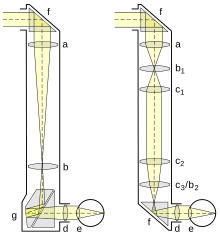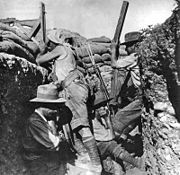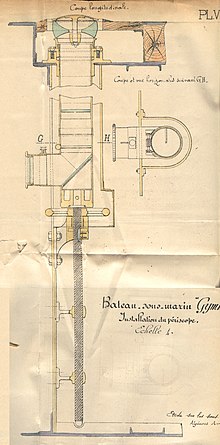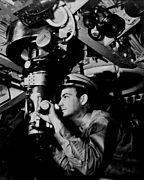
A sextant is a doubly reflecting navigation instrument that measures the angular distance between two visible objects. The primary use of a sextant is to measure the angle between an astronomical object and the horizon for the purposes of celestial navigation.
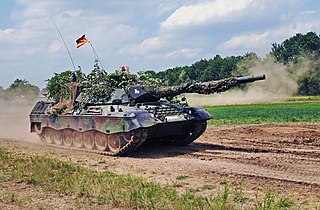
The Kampfpanzer Leopard is a main battle tank designed by Porsche and manufactured by Krauss-Maffei in West Germany, first entering service in 1965. Developed in an era when HEAT warheads were thought to make conventional heavy armour of limited value, the Leopard design focused on effective firepower and mobility instead of heavy protection. It featured moderate armour, only effective against low caliber autocannons and heavy machine guns, giving it a high power-to-weight ratio. This, coupled with a modern suspension and drivetrain, gave the Leopard superior mobility and cross-country performance compared to most other main battle tanks of the era, only being rivaled by the French AMX-30 and Swedish Strv 103. The main armament of the Leopard consisted of a German license-built version of the British Royal Ordnance L7 105 mm rifled gun, one of the most effective and widespread tank guns of the era.
The Gundlach Periscope, usually known under its British designation as Vickers Tank Periscope MK.IV, was a revolutionary invention by Polish engineer Rudolf Gundlach, manufactured for Polish 7TP tanks from the end of 1935 and patented in 1936 as the Peryskop obrotowy Gundlacha. It was the first device to allow the tank commander to have a 360-degree view from his turret with a single periscope. By rotating the periscope and allowing the tank commander to look backwards through the second eyepiece, he no longer had to change position to look behind the turret. Early tanks had small turrets and fixed seating, without an independently rotating cupola, and so the commander wasn't easily able to move himself to another rear-facing periscope.

The Apollo primary guidance, navigation, and control system was a self-contained inertial guidance system that allowed Apollo spacecraft to carry out their missions when communications with Earth were interrupted, either as expected, when the spacecraft were behind the Moon, or in case of a communications failure. The Apollo command module (CM) and lunar module (LM), were each equipped with a version of PGNCS. PGNCS, and specifically its computer, were also the command center for all system inputs from the LM, including the alignment optical telescope, the radar system, the manual translation and rotation device inputs by the astronauts as well as other inputs from the LM systems.
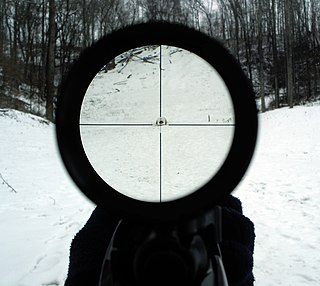
A telescopic sight, commonly called a scope informally, is an optical sighting device based on a refracting telescope. It is equipped with some form of a referencing pattern – known as a reticle – mounted in a focally appropriate position in its optical system to provide an accurate point of aim. Telescopic sights are used with all types of systems that require magnification in addition to reliable visual aiming, as opposed to non-magnifying iron sights, reflector (reflex) sights, holographic sights or laser sights, and are most commonly found on long-barrel firearms, particularly rifles, usually via a scope mount. Similar devices are also found on other platforms such as artillery, tanks and even aircraft. The optical components may be combined with optoelectronics to add night vision or smart device features.

The BRDM-2 is an amphibious armoured scout car designed and developed in the Soviet Union. It was also known under the designations BTR-40PB, BTR-40P-2 and GAZ 41-08. This vehicle, like many other Soviet designs, has been exported extensively and is in use in at least 38 countries. It was intended to replace the older BRDM-1, and has improved amphibious capabilities and better armament compared to its predecessor. The BRDM-2 production continues in Poland as of 2022.

A conning tower is a raised platform on a ship or submarine, often armoured, from which an officer in charge can conn the vessel, controlling movements of the ship by giving orders to those responsible for the ship's engine, rudder, lines, and ground tackle. It is usually located as high on the ship as is practical, to give the conning team good visibility of the entirety of the ship, ocean conditions, and other vessels.

The octant, also called a reflecting quadrant, is a reflecting instrument used in navigation.
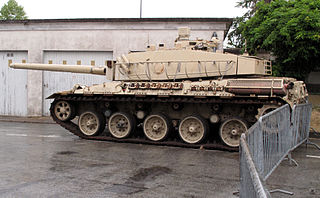
The AMX-32 was a French main battle tank developed by AMX and APX in the late 1970s during the Cold War as an export tank to fit in a specific market niche of nations with smaller defence budgets. While six prototypes were built, it failed to garner interest for foreign sales.

The SK-105 Kürassier is an Austrian light tank armed with a rifled 105 mm gun in an oscillating turret. It is estimated that over 700 have been produced, with initial deliveries in 1971. It shares its CN 105-57 main gun with the French AMX-13, which was widely produced and deployed.

The Type 61 tank is a main battle tank developed and used by the Japan Ground Self-Defense Force (JGSDF), built by Mitsubishi Heavy Industries.
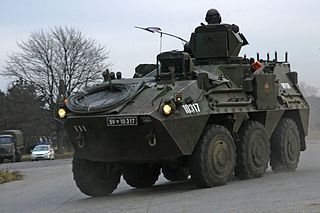
Lahko kolesno oklepno vozilo Valuk is an improved version of Pandur 6X6 APC, manufactured under a license manufacturing agreement with the Austrian company, Steyr Daimler Puch Spezialfahrzeug AG & Co KG, by Sistemska Tehnika of Slovenia for the Slovenian Army.

A stadimeter is an optical device for estimating the range to an object of known height by measuring the angle between the top and bottom of the object as observed at the device. It is similar to a sextant, in that the device is using mirrors to measure an angle between two objects but differs in that one dials in the height of the object. It is one of several types of optical rangefinders, and does not require a large instrument, and so was ideal for hand-held implementations or installation in a submarine's periscope. A stadimeter is a type of analog computer.

The Dozor-B is a four-wheeled Ukrainian armored car.

The defense industry of Turkey has a long history, dated from the Ottoman Empire, and has changed several times during the Republic period.

The OF-40 is an Italian main battle tank developed as a joint venture between OTO Melara and Fiat, and intended primarily for export sales. OTO Melara would develop and produce the hulls, and automotive components would be provided by Fiat. Initial design work was started by OTO Melara in 1977, with the first prototypes ready by 1980.
The Vickers Main Battle Tank Mk. 4 later known as the Vickers Valiant was a main battle tank developed as a private venture by British company Vickers for export. Its development began in 1976 and ended in January 1984. Although the Valiant did not enter production, its development provided valuable experience in the production of an aluminium-hulled, Chobham-armoured tank in the 40 tonnes weight range. A further development of its turret was later used for the Vickers Mk. 7 MBT.

A prism sight or prismatic sight, sometimes also called prism scope or prismatic scope, is a type of telescopic sight which uses a reflective prism for its image-erecting system, instead of the series of relay lenses found in traditional telescopic sights. The use of prisms makes it possible to construct a shorter and lighter sight, or with an offset between the eyepiece and objective axes.
The Vickers Main Battle Tank Mark 7 was a main battle tank developed on the basis of a joint venture between Vickers Defence Systems in the United Kingdom and Krauss-Maffei of Germany. It combined the Leopard 2 chassis with the Universal Turret previously developed for the Vickers Valiant main battle tank. The Vickers Mk. 7 was a key milestone in the development of the Challenger 2 as many of the features developed and successfully demonstrated in the turret of the Vickers Mk. 7 were later incorporated into the Challenger 2.

